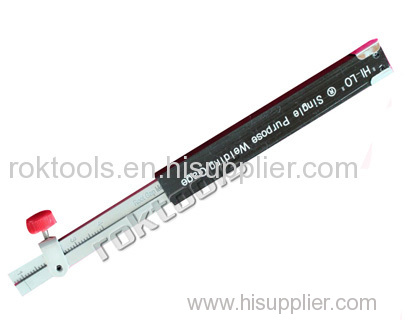
Single Purpose hi-lo Welding Gauge for Internal alignment of Pipe
| Min. Order: | 1 Piece/Pieces |
|---|---|
| Payment Terms: | T/T, paypal, WU |
| Supply Ability: | 1002 |
| Place of Origin: | Guangdong |
Company Profile
| Location: | China (Mainland) |
|---|---|
| Business Type: | Manufacturer, Trading Company |
Product Detail
| Model No.: | WG-602 |
|---|---|
| Means of Transport: | Ocean, Air, Land |
| Brand Name: | ROKTOOLS |
| Material: | stainless steel |
| package: | leather pouch |
| weight: | 0.1kg |
| Production Capacity: | 1002 |
| Delivery Date: | 10-20 |
Product Description
Single porpose hi-lo welding gauge , inspection tools
Part No: WG-602
manufacturer: Rok International Industry Co., Limited.
Original: China
designed for internal alignment and determining rootweld spacing.
You can check the internal alignment of your fit-up quickly with the WG-2 HI-LO Gage.
1. unlock the retaining screws. Press the gage legs beyond the barrel.
2. insert the legs ( wires ) into the root gap space of the two pieces of pipe to be fitted. Turn the gage 90 º, being careful to apply a constant back pressure to the barrel.
3. Hold the gage as square as possible with the fitting to obtain an accurate reading. Lock the retaining screw, Reverse the 90º turn and remove the gage. You've now ready to read the increment opposite the red line. 4. When the red line aligns with the 1/32 increment you have a good internal alignment and fit-up. Misalignment can be determined from the zero line by increment markings of 1/16 inch.
4. When the red line aligns with the 1/32 increment you have a good internal alignment and fit-up. Misalignment can be determined from the zero line by increment markings of 1/16 inch.
Rootweld spacing gage. Easy operation determines rootweld spacing.
1. Unlock the retaining screw and insert the gage interior alignment stops between the two pieces of pipe to be fitted.
2. Insert the leg with the long taper into the root gap until it makes contact with both sides of the gap.
Relock the retaining screw, remove the gage and read it.
3. The scale is calibrated in fractional dimensions from 1/32 to 3/16 inch in 1/16 inch increment markings. The readout you receive represents the amount of the rootweld gap.
Weld quality assurance is the use of technological methods and actions to test or assure the quality of welds, and secondarily to confirm the presence, location and coverage of welds.[original research?] In manufacturing, welds are used to join two or more metal surfaces. Because these connections may encounter loads and fatigue during product lifetime, there is a chance they may fail if not created to proper specification.
One element critical to a weld quality system is the final examination of the weld. Fabricators rely on radiography or ultrasound to check weld integrity. However, deficient welds can often be identified through visual inspection.
Visual weld inspection has the benefit of being able to be done in-house, causes minimal production delays and provides immediate feedback to welders and designers.
This article identifies the various types of weld discrepancies and discusses some visual weld inspection methods.

